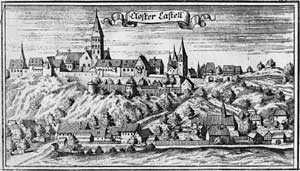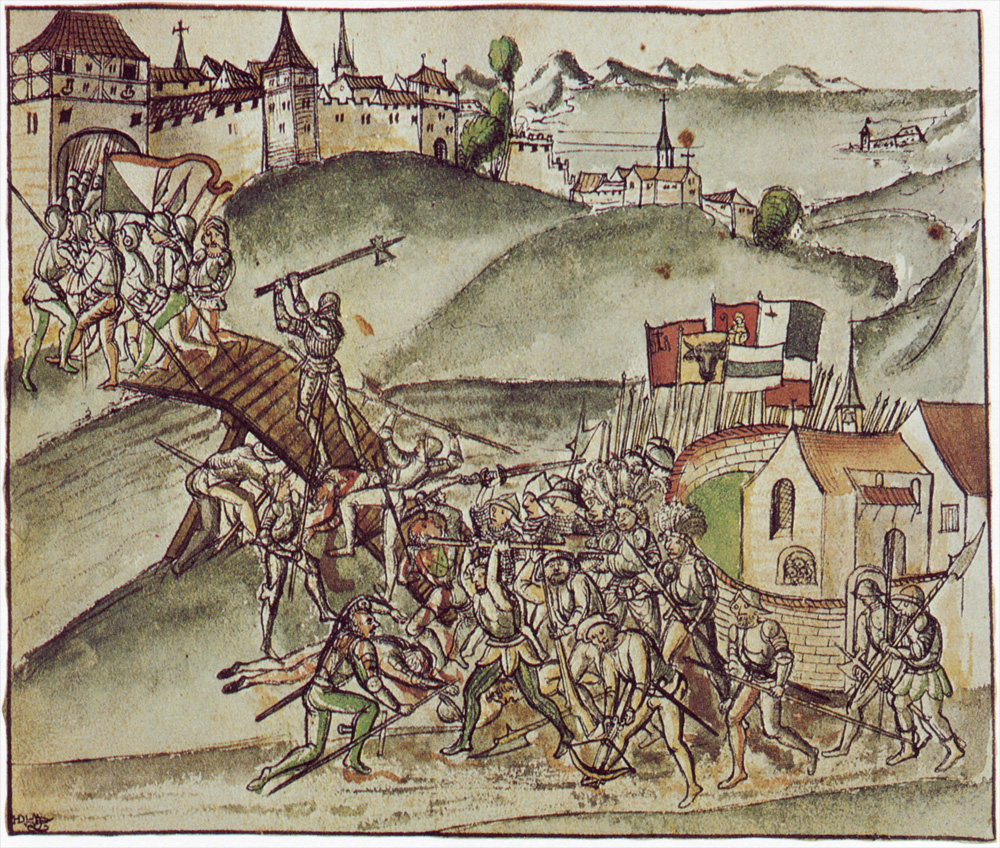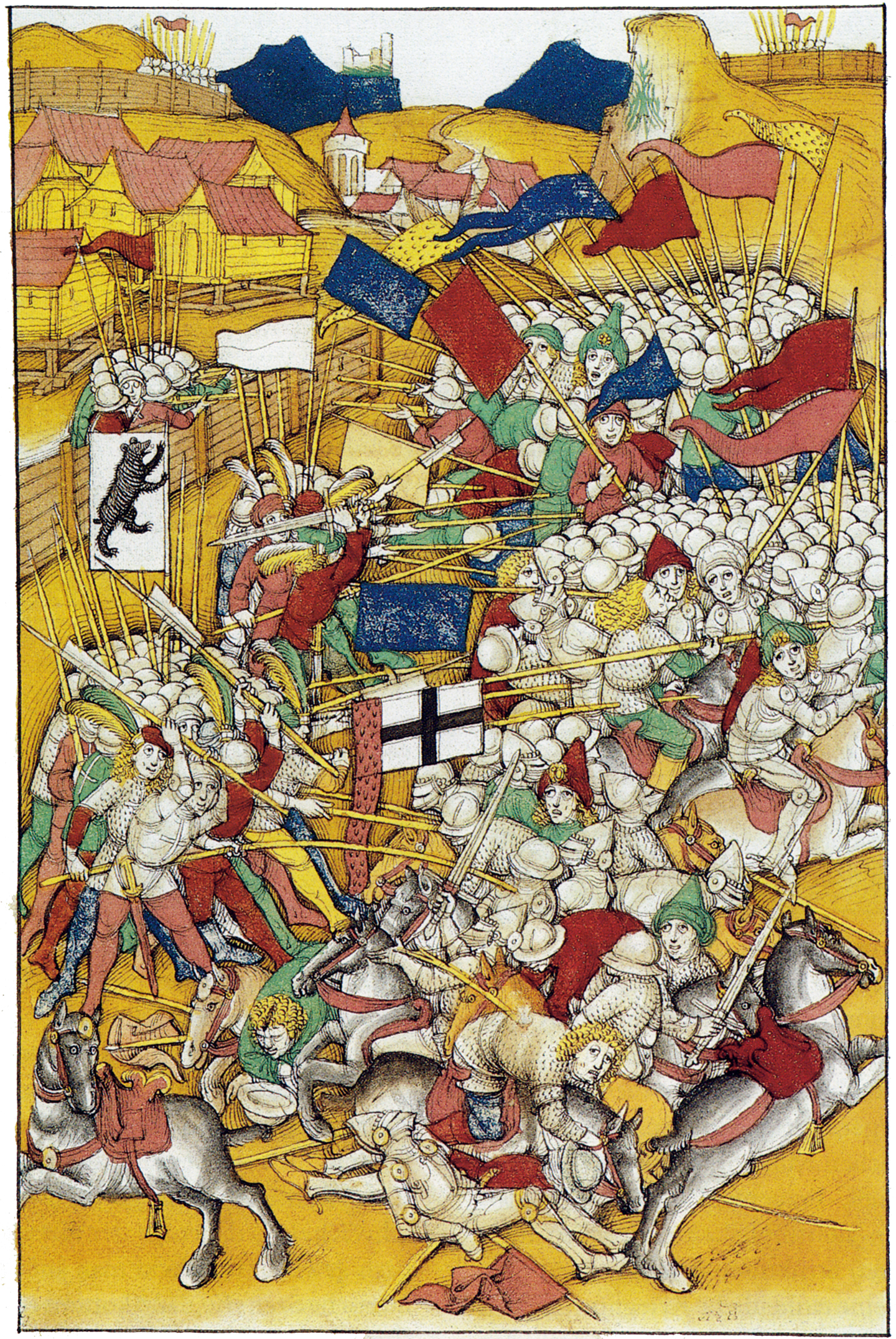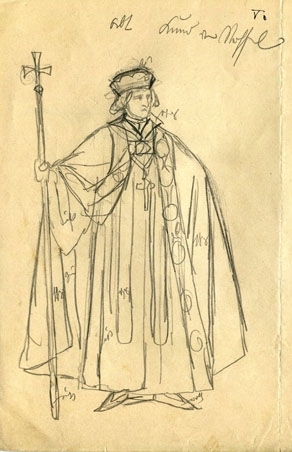|
Eglolf Blarer
Eglolf Blarer (born in Konstanz; died 20 May 1442) was abbot of the Abbey of Saint Gall from 1426 to 1442. Life Eglolf descended from the important middle-class Blarer trade family who were initially native to Saint Gall, but had for one generation been living in Konstanz. He was a monk in Saint Blaise Abbey holding the offices of ''Grosskeller'' and prior. Pope Martin V appointed him Abbot of Saint Gall at the end of 1426 or at the beginning of 1427. Eglolf is first documented holding office on 25 January 1427. "In 1436, he received the prerogative from the Council in Basel to let himself be consecrated by any bishop or abbot, should the ordinary (dt. "Ordinarius") refuse to consecrate him, as well as the prerogative to autonomously decide on vicars for the parishes of the city who were juridically subordinated to the abbot and the convent." Emperor Sigismund confirmed on 28 November 1430 the prerogatives as well as the fiefs and rights, and so did his successor, Albert II, ... [...More Info...] [...Related Items...] OR: [Wikipedia] [Google] [Baidu] |
Konstanz
Konstanz (, , locally: ; also written as Constance in English) is a university city with approximately 83,000 inhabitants located at the western end of Lake Constance in the south of Germany. The city houses the University of Konstanz and was the residence of the Roman Catholic Diocese of Konstanz for more than 1,200 years. Location The city is located in the state of Baden-Württemberg and situated at the banks of Lake Constance (''Bodensee'' in German). The river Rhine, which starts in the Swiss Alps, passes through Lake Constance and leaves it, considerably larger, by flowing under a bridge connecting the two parts of the city. North of the river lies the larger part of the city with residential areas, industrial estates, and the University of Konstanz; while south of the river is the old town, which houses the administrative centre and shopping facilities in addition to the ''Hochschule'' or the ''University of Applied Sciences''. Car ferries provide access across Lake Cons ... [...More Info...] [...Related Items...] OR: [Wikipedia] [Google] [Baidu] |
Heinrich Von Mansdorf
Heinrich von Mansdorf (born before 1419; died 13 September 1426 in Freiburg im Breisgau) was abbot of the Abbey of Saint Gall from 1419 to 1426. Life Heinrich became Abbot of Saint Gall after Konrad von Pegau had abdicated. He was appointed by Pope Martin V. Before that, he had been provost of the Abbey of Schkölen in the Bishopric of Naumburg-Zeitz. Works As was the custom, Heinrich soon after his inauguration, on 9 July 1419, confirmed the rights and liberties of the city of Saint Gall. On 10 und 11 August 1419, he confirmed those of the city of Wil and on 27 August those of the city of Wangen. Abbot Heinrich tried to enhance the economic foundation of the abbey. To this end, he wanted to resolve the dispute with Appenzell, which had begun during the reign of Kuno von Stoffeln and had culminated in the Appenzell Wars in which Saint Gall had been defeated. For 11 years, the Appenzeller had been refusing to pay interest. The seven villages held several fruitless law confere ... [...More Info...] [...Related Items...] OR: [Wikipedia] [Google] [Baidu] |
Year Of Birth Unknown
A year or annus is the orbital period of a planetary body, for example, the Earth, moving in its orbit around the Sun. Due to the Earth's axial tilt, the course of a year sees the passing of the seasons, marked by change in weather, the hours of daylight, and, consequently, vegetation and soil fertility. In temperate and subpolar climate, subpolar regions around the planet, four seasons are generally recognized: spring (season), spring, summer, autumn and winter. In tropics, tropical and subtropics, subtropical regions, several geographical sectors do not present defined seasons; but in the tropics#Seasons and climate, seasonal tropics, the annual wet season, wet and dry seasons are recognized and tracked. A calendar year is an approximation of the number of days of the Earth's orbital period, as counted in a given calendar. The Gregorian calendar, or modern calendar, presents its calendar year to be either a common year of 365 days or a leap year of 366 days, as do t ... [...More Info...] [...Related Items...] OR: [Wikipedia] [Google] [Baidu] |
Kastl Abbey
Kastl Abbey (german: Kloster Kastl) is a former Benedictine monastery in Kastl in the Upper Palatinate, Bavaria. History The monastery, dedicated to Saint Peter, was founded in 1103, or shortly before, by Count Berengar II of Sulzbach together with Frederick and Otto, Counts of Kastl-Habsberg. It was dissolved in 1563 in the course of the Reformation, but re-established as a Catholic monastery in 1625. From 1636 the building was used by the Jesuits, from 1773 by the Knights Hospitallers. Dissolved again in 1803, it was the seat of the Provincial Court until 1862. From 1958 to 2006 the buildings housed a Hungarian secondary boarding school, now closed. Princess Anna Anna, daughter of Emperor Louis IV, died here on 29 January 1319 aged 18 months. Her body was not taken to Munich but was entombed in the monastery. In 1715 the body was removed from its tomb and kept in an oak cupboard. Later, preserved as a mummy, it lay in a shrine in the entrance hall to the monastery churc ... [...More Info...] [...Related Items...] OR: [Wikipedia] [Google] [Baidu] |
Rule Of Saint Benedict
The ''Rule of Saint Benedict'' ( la, Regula Sancti Benedicti) is a book of precepts written in Latin in 516 by St Benedict of Nursia ( AD 480–550) for monks living communally under the authority of an abbot. The spirit of Saint Benedict's Rule is summed up in the motto of the Benedictine Confederation: ''pax'' ("peace") and the traditional '' ora et labora'' ("pray and work"). Compared to other precepts, the Rule provides a moderate path between individual zeal and formulaic institutionalism; because of this middle ground it has been widely popular. Benedict's concerns were the needs of monks in a community environment: namely, to establish due order, to foster an understanding of the relational nature of human beings, and to provide a spiritual father to support and strengthen the individual's ascetic effort and the spiritual growth that is required for the fulfillment of the human vocation, theosis. The ''Rule of Saint Benedict'' has been used by Benedictines for 15 centur ... [...More Info...] [...Related Items...] OR: [Wikipedia] [Google] [Baidu] |
Hersfeld Abbey
Hersfeld Abbey was an important Benedictine imperial abbey in the town of Bad Hersfeld in Hesse (formerly in Hesse-Nassau), Germany, at the confluence of the rivers Geisa, Haune and Fulda. The ruins are now a medieval festival venue. History Hersfeld was founded by Saint Sturm, a disciple of Saint Boniface, before 744. Because its location rendered it vulnerable to attacks from the Saxons, however, he transferred it to Fulda. Some years later, in or about 769 after the defeat of the Saxons by the Franks, Lullus, archbishop of Mainz, re-founded the monastery at Hersfeld. Charlemagne (who had recently succeeded to the Frankish royal crown) and other benefactors provided endowments, and in 775 gave it the status of a ''Reichsabtei'' "imperial abbey" (i.e., territorially independent prince-abbacy within the Empire). Pope Stephen III granted it exemption from episcopal jurisdiction. It soon possessed 1050 hides of land and a community of 150 monks. Lullus was buried in the ch ... [...More Info...] [...Related Items...] OR: [Wikipedia] [Google] [Baidu] |
Swiss Confederation
). Swiss law does not designate a ''capital'' as such, but the federal parliament and government are installed in Bern, while other federal institutions, such as the federal courts, are in other cities (Bellinzona, Lausanne, Luzern, Neuchâtel, St. Gallen a.o.). , coordinates = , largest_city = Zürich , official_languages = , englishmotto = "One for all, all for one" , religion_year = 2020 , religion_ref = , religion = , demonym = , german: Schweizer/Schweizerin, french: Suisse/Suissesse, it, svizzero/svizzera or , rm, Svizzer/Svizra , government_type = Federal assembly-independent directorial republic with elements of a direct democracy , leader_title1 = Federal Council , leader_name1 = , leader_title2 = , leader_name2 = Walter Thurnherr , legislature = Federal Assembly , upper_house = Council of Stat ... [...More Info...] [...Related Items...] OR: [Wikipedia] [Google] [Baidu] |
Schwyz
The town of Schwyz (; french: Schwytz; it, Svitto) is the capital of the canton of Schwyz in Switzerland. The Federal Charter of 1291 or ''Bundesbrief'', the charter that eventually led to the foundation of Switzerland, can be seen at the ''Bundesbriefmuseum''. The official language of Schwyz is (the Swiss variety of) German, but the main spoken language is the local variant of the Alemannic Swiss German dialect. Name The earliest certain record of the name dates to 972, recorded in Medieval Latin as '. There are a number of uncertain records dated between 924 and 960, in the form ''Swites'' (''Suuites'') and ''Switz''. The name is recorded as ''Schwitz'' in the 13th century, and in the 17th to 18th century often as ''Schweitz''. The name's etymology is uncertain. It was long presented as derived from the name of an eponymous founder in Swiss legend, one ''Suito'' or ''Switer'', an explanation found in Swiss school textbooks until the first half of the 20th century. ... [...More Info...] [...Related Items...] OR: [Wikipedia] [Google] [Baidu] |
Old Zürich War
The Old Zurich War (german: Alter Zürichkrieg), 1440–46, was a conflict between the canton of Zurich and the other seven cantons of the Old Swiss Confederacy over the succession to the Count of Toggenburg. In 1436, Count Friedrich VII of Toggenburg died, leaving neither heir nor will. The canton of Zurich, led by burgomaster Rudolf Stüssi, claimed the Toggenburg lands; the cantons of Schwyz and Glarus made counter-claims, backed by the other cantons. In 1438 Zurich occupied the disputed area and cut off grain supplies to Schwyz and Glarus. In 1440, the other cantons expelled Zurich from the confederation and declared war. Zurich retaliated by making an alliance with Frederick III, Holy Roman Emperor of the house of Habsburg. The forces of Zurich were defeated in the Battle of St. Jakob an der Sihl on 22 July 1443 and Zurich was besieged. Frederick appealed to Charles VII of France to attack the confederates and the latter sent a force of about 30,000 Armagnac mercena ... [...More Info...] [...Related Items...] OR: [Wikipedia] [Google] [Baidu] |
Appenzell Wars
The Appenzell Wars (german: Appenzeller Kriege) were a series of conflicts that lasted from 1401 until 1429 in the Appenzell region of modern-day Switzerland. The wars consisted of uprisings of cooperative groups, such as the farmers of Appenzell or the craftsmen of the city of St. Gallen, against the traditional medieval power structure represented by the House of Habsburg and the Prince-Abbot of the Abbey of St. Gall. The conflict was one of a number of popular revolts in late-medieval Europe. It resulted in greater autonomy for Appenzell and its association with the Old Swiss Confederacy, of which it would become a member (canton) in 1513. Background Appenzell (the name in la, abbatis cella means "cell (i.e. estate) of the abbot") had been under the personal control of the abbot of St. Gall. While the Prince-Abbot appointed agents or bailiffs, the communities in Appenzell were governed by a council appointed by the '' Landsgemeinde'', in which every citizen could vote. ... [...More Info...] [...Related Items...] OR: [Wikipedia] [Google] [Baidu] |
Abbot
Abbot is an ecclesiastical title given to the male head of a monastery in various Western religious traditions, including Christianity. The office may also be given as an honorary title to a clergyman who is not the head of a monastery. The female equivalent is abbess. Origins The title had its origin in the monasteries of Egypt and Syria, spread through the eastern Mediterranean, and soon became accepted generally in all languages as the designation of the head of a monastery. The word is derived from the Aramaic ' meaning "father" or ', meaning "my father" (it still has this meaning in contemporary Hebrew: אבא and Aramaic: ܐܒܐ) In the Septuagint, it was written as "abbas". At first it was employed as a respectful title for any monk, but it was soon restricted by canon law to certain priestly superiors. At times it was applied to various priests, e.g. at the court of the Frankish monarchy the ' ("of the palace"') and ' ("of the camp") were chaplains to the Merovingi ... [...More Info...] [...Related Items...] OR: [Wikipedia] [Google] [Baidu] |
Kuno Von Stoffeln
Kuno von Stoffeln (born before 1365; died 19 October 1411) was from 1379 until his death Prince abbot of Saint Gall. He descended from the family von Stoffeln with property on Castle Hohenstoffeln on the Hohenstoffeln at Hegau. He was substantially involved in the Appenzell Wars as the city refused to pay homage to him, and the Appenzellers, his subjects, even refused to pay taxes. Due to the price decline of grain after a disastrous plague epidemic, Kuno had been obliged to drastically increase taxes in order to balance the loss of revenue. He first aligned with cities at Lake Constance that were devoted to him and later with Duke Frederick IV of Austria Frederick IV (1382 – 24 June 1439), also known as Frederick of the Empty Pockets (german: Friedrich mit der leeren Tasche), a member of the House of Habsburg, was Duke of Austria from 1402 until his death. As a scion of the Habsburg Leopoldian ... in order to put an end to the population's attempts at freedom. He was not gr ... [...More Info...] [...Related Items...] OR: [Wikipedia] [Google] [Baidu] |








